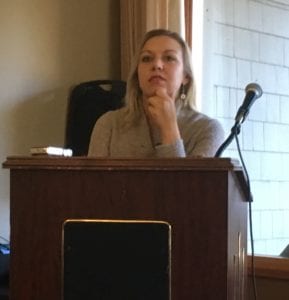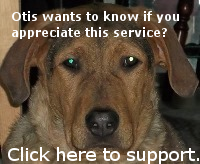Southeast Conference is gearing up for Phase 2 of its Alaska Marine Highway System reform project. The regional economic development organization took on the project with the goal of improving state ferry service, which provides transportation to and from coastal Alaska communities.
Southeast Conference Board President Chelsea Goucher gave an overview of Phase 1 during a presentation this week at the Ketchikan Chamber of Commerce lunch.
Southeast Conference formed about 58 years ago, and its goal way back then was to create a regional ferry system. Since then, Southeast Conference has branched out to other economic interests. But, Goucher told the Chamber audience,

Southeast Conference Board President Chelsea Goucher listens to a comment during the Ketchikan Chamber of Commerce. (Photo by Leila Kheiry)
“We are back focusing on the Marine Highway System. And of course, the reason for that is that the Marine Highway System is something integral to Southeast Alaska, but like many things that are not glamorous, like transportation and energy, it gets taken for granted. And a lot of other people around the state don’t realize the importance of the Marine Highway System, not only to the region but to other regions like Southwest Alaska and the entire state as a whole.”
With continued cuts to the ferry system leading to uncertain schedules and cutbacks in service, Southeast Conference offered to work with the State of Alaska to come up with a plan to reform the system.
Phase 1 of that plan is pretty much done. It was the easy part, Goucher said. Or, at least, easier.
They formed a steering committee, with members from all over the state – not just those from communities served by the ferry system. And they hired contractors to compile and condense already-collected data from the many ferry system studies that have been conducted over the years.
Goucher said the steering committee and contractors also worked to gather input from user groups throughout the Phase 1 process, starting with a statewide summit.
“And that was one thing that Southeast Conference really wanted to make sure that we did, and did right, was get a lot of input from people, because the worse thing ever to do is do a huge study and have this beautiful product, and then all the stakeholders that weren’t in the room speak up and say, ‘Where were we?’”
The group eventually came up with vision and mission statements, which Goucher said was an important process because it helped them focus on specific goals. And they looked at different ferry systems from around the world to see what kind of model would work for Alaska.
The current model, Goucher said, doesn’t work. Right now, the Alaska Marine Highway System is run by the state Department of Transportation, which also is in charge of all the state roads and public facilities. That department’s resources are spread thin, especially now.
Goucher spelled out some of the problems with the current system.
“Obviously, there’s funding uncertainty, because we’re a line-item in the state budget. Everything is uncertain until a budget is passed and agreed upon, and nothing is vetoed or not vetoed. And that usually happens like a month before the Marine Highway System is supposed to have its schedule out. And so, it’s a huge mess – it creates a kind of uncertainty where people don’t even – if you’re a tourist, or someone coming back from college and you don’t even know what the schedule is going to be in May or June, it’s very difficult to plan for that.”
Another downside Goucher mentioned is that the ferry system can be somewhat of a political game piece, used as leverage by some lawmakers trying to gain support for other legislation.
And, she said, it’s challenging for government to respond quickly when the market shifts.
With those issues in mind, the group recommended changing the management structure to a state corporation. That would create two entities with different responsibilities toward the ferry system.
“So, one part of that would be a private group that would manage the actual ferries and the facilities that, where you do your bookings and that sort of thing. And that would be governed by a board of directors with private-sector expertise.”
That would provide more management stability, Goucher said, and make the system less vulnerable to political influence. But,
 “It would still be part of the state government, and therefore would have the advantages of being able to access state and federal government money.”
“It would still be part of the state government, and therefore would have the advantages of being able to access state and federal government money.”
That federal funding, in particular, is why the steering committee wants the ferry system to remain under state ownership. A fully private system would not be eligible for federal money.
And that’s pretty much the end of Phase 1. Now, they’re moving into Phase 2. That’s going to involve more intense market research regionally, statewide and around the world; operational analysis and modeling; capital needs; and financial modeling.
“Part of the goal of Phase 2 is, through this research, to create a clear case for why a public corporation is going to be more efficient than the current status quo.”
They also will need to come up with a way to convince the Legislature that this change is needed.
As the reform plan continues to be developed, Goucher said the steering committee came up with some interim recommendations to the state. Those include forward funding for the system, to allow for better planning; transferring labor management to the Marine Highway System; and allowing managers to establish partnerships to improve service.
Following the presentation, local business owner Terry Wanzer asked whether the steering committee would look into restoring some services that have been cut from the ferry system, such as on-board bars and gift shops.
Goucher liked that suggestion, and said she would bring it up at the Southeast Conference’s mid-session summit in March.
“Like on the IFA, it’s a private company that runs the restaurant on there, so that can be a really great opportunity for entrepreneurs that maybe want to ride around Southeast Alaska and sell curios. That can be a great thing for somebody, and those are those things that add value to the system.”
The IFA, or Inter-Island Ferry Authority, operates a ferry run between Ketchikan and Prince of Wales Island.
Like with Phase 1, Goucher said the second phase of the project will include a lot of public input. She encourages people throughout the region to get involved in the process and provide their thoughts on making the Alaska Marine Highway System better for everyone.
You can see the full Phase 1 report on this page of the Southeast Conference website.






